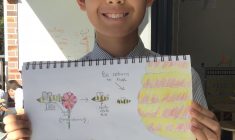Learning Enhancement – Sketchnotes
Sketchnoting in Year 5
More than Just a Pretty Page – In Year 5 we have learning why and how people use Sketchnotes. From the beginning of the year we have been learning how to sketchnote during reading comprehension and writing lessons. We see examples of sketchnotes all around us, as advertisements, in articles and on social media. Sketchnoting can add fun and variety into the routine practice of notetaking, furthermore it can assist us in the following ways:
Sketchnotes Are Thinking Made Visible
‘Imagine learning to dance when the dancers around you are all invisible. Imagine learning a sport when the players who already know the game can’t be seen. Bizarre as this may sound, something close to it happens all the time in one very important area of learning: learning to think. Thinking is pretty much invisible.’ (David Perkins Harvard Professor). Sketchnoting on the other hand, unleashes a reader’s thinking in short order, with colours, shapes and letters.
Sketchnotes Allow for Student Choice
When sketchnoting whoever holds the pen holds the power. Only the thinker decides what appears on the page, and how. Giving student choice is an indicator of best practice and personalised annotation allows for maximum student choice.
Sketchnotes Help Strengthen Memory
A recent study suggests that we remember lectures when we listen and write with pen and paper instead of typing our notes at a keyboard (Mueller and Oppenheimer 2014). It has been proposed that a shallow kind of processing occurs when notes are typed, because those who type their notes tend to capture lectures word for word. When sketchnoting, it’s not about regurgitating passages of text verbatim. It is about taking new ideas and information and running them through the brain, using background knowledge to generate new thinking.
Aleca Bradshaw – Learning Enhancement Team Leader







